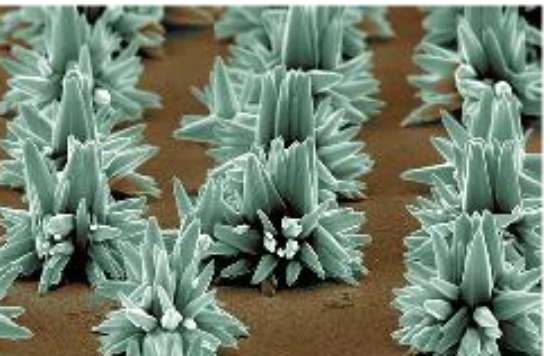The War on Cancer Goes Stealth
With nanomedicine, the strategy is not to poison cancer cells or to blast them away but to trick them
![]()

Zinc oxide nanoparticles. Courtesy of National Institutes of Health.
So, we’re 42 years into the War on Cancer, and while the enemy remains formidable, our strategy is shifting into yet another phase. We’ve been through the equivalent of hand-to-hand combat–surgery–carpet bombing–radiation–and chemical warfare–chemotherapy.
Now the fight is about stealth. Instead of concentrating on blasting away at cancer cells, or poisoning them, you’re more likely to hear cancer scientists talk about “Trojan horses” or “cloaking strategies” or “tricking” the immune system. All are cell-level ploys hatched through nanomedicine–medical treatment gone very, very small. How small? At the nano level, about 5,000 particles would be as wide as a human hair.
We are not the enemy
Okay, so we’re in beyond comprehension territory here. But let’s not get hung up on size; let’s focus on deception.
The latest example of microscopic trickery was laid out last week a paper from researchers at the University of Pennsylvania. One of the most appealing aspects of nanomedicine is that it allows scientists to deliver drugs directly to a tumor instead flooding the whole body with chemotherapy. Unfortunately, the immune system sees the nanoparticles as invaders and tries to clear them away before they can go to work on the tumor cells.
The trick was to make the “sentry cells” of the body’s immune system think that the drug-delivering nanoparticles were native cells, that they weren’t intruders. The researchers did this by attaching to each nanoparticle a protein that’s present in every cell membrane. And put simply, it sent out a “don’t eat me” message to the body’s guard cells.
The result, at least in mice, is that this technique dramatically improved the success rate of two different kinds of nanoparticles–one that delivered tumor-shrinking drugs and one filled with dye that would help doctors capture images of cancer cells.
Meanwhile, earlier this year, scientists at the Methodist Hospital Research Institute in Houston announced that they had found their own way of letting nanoparticles fool the immune system. They developed a procedure to physically remove the membranes from active white blood cells and drape them over nanoparticles. And that “cloaking strategy” was enough to keep proteins that activate the immune system from doing their job and ordering it to go repel the invaders. The researchers believe it will one day be possible to harvest a patient’s own white blood cells and use them to cloak the nanoparticles, making it that much more likely that they’ll get to their target without being attacked.
As magical as all this can sound, nanomedicine is not without risk. Much more research needs to be done on the long-term impact of nanoparticles inside the body. Could they accumulate in healthy body tissues? And if they do, what effect would it have? Can those tiny particles now seemingly so full of promise, eventually turn toxic?
Still plenty of questions about nanomedicine, but it’s feeling more like an answer.
Small talk
Here are six other ways in which thinking small is moving medicine forward:
1) But first, remove all jewelery: At the University of Minnesota, scientists are experimenting with nanoparticles and magnets to fight lung cancer. They’ve developed an aerosol inhalant that a patient can draw into his or her lungs with a few deep breaths. And that carries iron oxide nanoparticles to tumors inside the lungs. Then, by waving a magnet outside the body, they can agitate the particles so that they heat up enough to kill cancerous cells around them.
2) A new shell game: A team of engineers at UCLA has developed tiny capsules--about half the size of the smallest bacterium–that are able to carry proteins to cancer cells and stunt the growth of tumors. And the nanoscale shells degrade harmlessly in non-cancerous cells.
3) Gold’s fool: And at Northwestern, researchers say they’ve found a way to use gold nanoparticles to effectively fight lymphoma. They fool the lymphoma cells into thinking they contain high-density lipoprotein (HDL), which the cells need to survive. The gold nanoparticles bind to the cancer cells and starve them of cholesterol.
4) Way better than Krazy Glue: In Germany, scientists have invented a paste made of nanoparticles that they say can makes broken bones repair themselves faster. The paste contains two growth-factor genes that enter cells and accelerate bone healing.
5) Alas, it can’t help you find meds you dropped on the floor: While technically not nanomedicine, a small smart pill that tracks if people are taking their medications correctly could soon be on the market. Approved by the FDA last year, the pill contains a tiny sensor that interacts with stomach fluid and sends a signal to a patch on a person’s body. Taken with a real medication, the smart pill transmits information about the other med, particularly when it was ingested, to a smartphone. But it also sends physiological data, including heart rate and activity level.
6) Body heat gone bad: Along the same lines, firemen in Australia have started taking a tiny capsule to protect them from being overcome by heat. Sensors in the pill are able to take their core body temperatures in real time and relay that data to a smart phone. And that has led to changes in firefighters’ work patterns, including the length of time they are exposed to blazes.
Video bonus: Still not clear on nanomedicine? Here’s a TED talk on how it’s being used to fight cancer by Mark Davis, a leading expert on the subject and a chemical engineer at the California Institute of Technology.
More from Smithsonian.com;
/https://tf-cmsv2-smithsonianmag-media.s3.amazonaws.com/accounts/headshot/randy-rieland-240.png)
/https://tf-cmsv2-smithsonianmag-media.s3.amazonaws.com/accounts/headshot/randy-rieland-240.png)